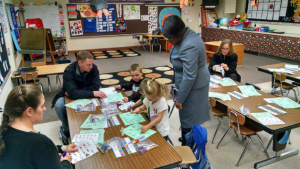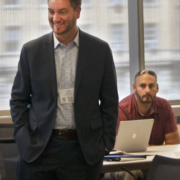Family Science & Engineering Nights are a Vehicle for Transportation Education
Article contributed by Joan Chadde, Michigan Technological University
Barkell Elementary School in Hancock and Chassell Elementary in Chassell, both small towns in Michigan’s Upper Peninsula, hosted Family Science and Engineering Nights recently, on Feb. 16 and March 15 respectively, for elementary-aged students and their parents or guardians. The event provided attendees with a hands-on learning experience focused on engineering and science, which also included a lesson on transportation.
Family Science and Engineering Nights are coordinated by Joan Chadde, director of the Center for Science and Environmental Outreach at Michigan Technological University, and a CFIRE partner since 2011.
These family events offer around 10 different activities that range from students designing their own launcher, to using the scientific method to choose the best chewing gum or making a transportation map. Families could attend two activities of their choosing.
“Family Science and Engineering Nights are a great way to engage elementary-aged students in learning about real world applications. The activities are mostly presented by college students who are excellent role models and enthusiastic about what they are teaching.” Chadde said. “We always have a great turnout—parents enjoy it as much as the youngsters!”
A diverse group of educators, including several graduate students from MTU and STEM specialists, presented. One of the students’ favorite activities focused on transportation.
MTU environmental policy graduate student, Ronesha Strozier, presented the, “Stop, Look and Listen,” activity to kindergarteners, 1st grade students, and their parents. Strozier taught young students what a transportation engineer does.
The kindergarteners and first-graders practiced responding to traffic signs and learned about the four modes of transportation—ships, planes, trucks and trains. They also practiced crossing the street safely. Lastly, students had to decide which traffic signs to use to make a busy intersection safe for children walking to school and to the park.

“I enjoy presenting because I want kids to experience science and engineering in a way that relates to their lives,” Strozier said.
Strozier attended the Midwest Transportation Workforce Summit: Addressing the Future Now! on December 7 and 8, 2015 at the University of Wisconsin-Madison. She is currently employed at the Transportation Technical Assistance Program at MTU.
“I want these youngsters to be comfortable seeing [a black woman] in these types of positions. I end each of my lessons with ‘Maybe one day I will see you in the office!’”
“The students learn about transportation and why it is important. We discuss traffic signs and how they help keep everyone safe. Then we pretend we are vehicles on a city street…it quickly becomes chaos without any signs to tell us when to stop or what speed to travel!” Strozier said. “The children quickly understand why traffic signs are so important!”
Strozier said students were able quickly understand that transportation helps them get to places they want to visit, like the ice cream shop, and brings products they may want to buy to stores and restaurants in their town.
“The students have a lot of fun, and so do I!” Strozier said.
To learn more or to connect with the creators of this project, contact Joan Chadde at jchadde@mtu.edu.
| This story is from our regular series of articles highlighting efforts being made here in the Midwest to address transportation workforce issues. We’d like to tell your story, too. Click here to fill out our simple form to get the ball rolling. We know there are great efforts being made across the region. Let’s share our successes! |

